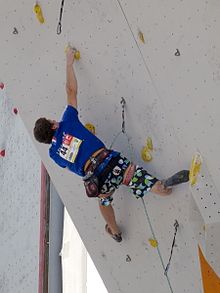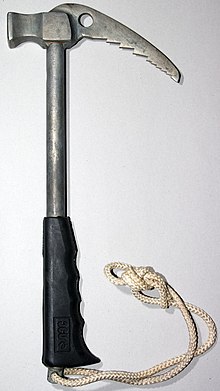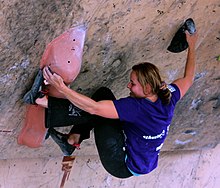Glossary of climbing terms
| Part of a series on |
| Climbing |
|---|
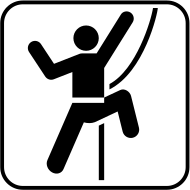 |
| Background |
| Types |
| Lists |
| Terms |
| Gear |
This glossary of climbing terms is a list of definitions of terms and jargon related to rock climbing and mountaineering.[1][2][3] The specific terms used can vary considerably between different English-speaking countries; many of the phrases described here are particular to the United States and the United Kingdom.
A[]
- Abalakov thread
-
A type of abseiling point used especially in winter and ice climbing.
- ablation zone
- The area of a glacier where annual melting meets or exceeds annual accumulation of snowfall.
- abseiling
The process by which a climber descends a fixed rope.
- add-on
- A climbing game, played indoors, where climbers take turns creating a route, usually adding two moves at a time. Climbers usually play until they reach a certain number of falls.[4]
- adze
- A thin blade mounted perpendicular to the handle on an ice axe that can be used for chopping footholds in snow or ice.
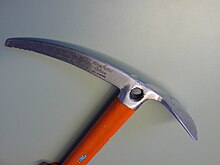 Ice ax with adze
Ice ax with adze - aid climbing
- Any style of climbing in which standing on or pulling oneself up via devices attached to fixed or placed protection is used to make upward progress.
- See etrier.
- alpine climbing
- Generally, any climbing that is done in the mountains, especially mountaineering. May include a mixture of ice climbing and dry-tooling. To climb "alpine style" generally means carrying all of one's gear in a backpack, even for multi-day climbs.
- Alpine cock ring (ACR)
- An anchor method similar to a cordelette but that is dynamically equalizing. It employs a cord and a rappel ring.[5]
- alpine knee
- To use one's knee as a way to gain ground on a climb.[6] Examples include the "'expansion knee,' by which the climber would overcome the lack of a piton large enough to fit a broad crack in the rock by inserting his knee into the crack, bending the leg to anchor, and hoisting himself up to a level where a piton might be inserted."[7]
- alpine start
- To make an efficient start on a long climb by packing all gear the previous evening and starting early in the morning, usually well before sunrise.[8]
- American death triangle
- An anchor which is created by connecting a closed loop of cord or webbing between two points of protection, and then suspending the rope from a carabiner clipped to only one strand of said anchor. This creates a triangular shape in the webbing or cord, which places massively multiplied inward forces on the protection, making it a dangerous, ineffective anchor.
- anchor
- An arrangement of one or (usually) more pieces of gear set up to support the weight of a belay or top rope.
- approach
- The path or route to the base of a technical climb.[1] Although this is generally a walk or, at most, a scramble, it is occasionally as hazardous as the climb itself. Special shoes called approach shoes are often preferred over climbing shoes for an approach.
 approach to climbing area
approach to climbing area - arête
- 1. A small ridge-like feature or a sharp outward-facing corner on a steep rock face.
 Climber climbing an arête
Climber climbing an arête - 2. A narrow ridge of rock formed by glacial erosion.
- 3. A method of indoor climbing in which one is able to use such a corner as a hold. See also dihedral.
- arm bar
- A technique in which a climber jams an arm into a crack and locks it into place.[1]
- arqué
- (from the French word meaning arched) Used to describe crimping. In this position, typically the first set of knuckles are hyperextended and the second have a sharp angle of about 90 degrees. This combines muscular effort with soft tissue tensions in order to apply the load. When used often, this position has been known to over-stress the tendons in fingers and lead to injuries.
- ascend
- To climb a rope using an aid device.
- ascender
- A device for ascending a rope.
- aspect
- The geographical direction which a particular slope or rock wall faces, e.g. "north aspect".
- ATC
- A proprietary belay device manufactured by Black Diamond. The term has become generic for any tubular belay device. ATC originally stood for "air traffic controller".[citation needed]
- automatic belay
- A fast method for setting up a two-point anchor in sport climbing, using the climbing rope to attach to the anchor points.
B[]
- "B"-grade
- A grading system for bouldering problems, invented by John Gill. Now largely superseded by the "V" grading system.
- Bachar ladder
- A piece of training equipment used to improve campusing and core strength.
- back-clipping
- A potentially hazardous mistake that can be made while lead climbing, whereby the rope is clipped into a quickdraw such that the leader's end runs underneath the quickdraw as opposed to over the top of it. If the leader falls, the rope may fold directly over the gate, causing it to open and release the rope from the carabiner.
- back-step
- Stepping on a hold in such a way that the outside edge (little toe side) of a shoe touches the rock, while the hips are turned to the side in such a way that the outside of a hip faces into the rock.[1][9][10]
 back-step
back-step - bail
- To retreat from a climb.
- ball nut
- A type of aid protection consisting of a nut and a movable ball.[11]
- barn-door
- If all points of contact a climber has with the wall are on a straight axis, or close to it, their body may be vulnerable to swinging uncontrollably downward around this axis, like a door on a hinge.
 The climber's right foot pressing on the rock is helping him to avoid a barn door swing to the right
The climber's right foot pressing on the rock is helping him to avoid a barn door swing to the right - bashie
- A copperhead intended for pounding into a crack.
- belay
- To protect a roped climber from falling by controlling the movement of the rope. This usually involves the use of a belay device. A belay can also be achieved using a Munter hitch, a hip belay, or by passing the rope around a rock or tree to increase friction.
- belay device
- A mechanical device used to increase the braking force when belaying. Many different types of belay device exist, including plates, figure eights, tubers, geometrical assisted-braking devices, mechanical assisted-braking devices, and centrifugal devices. Some belay devices may also be used as a descender.
- belay loop
- The strongest point on a climbing harness; the loop to which a belay device is physically attached. The belay loop will wear more quickly if anything is tied around the belay loop such as a daisy chain or sling.
- belay off
- Called out by a belayer to confirm that the friction or pressure of belaying has been removed from a climbing rope. It is a standard response to a climber's "off belay" request.
- belay on
- Called out by a belayer to confirm that the friction or pressure of belaying has been (re)applied to a climbing rope. It is a standard response to a climber's "on belay" request.
- belay station
- The place from which a belayer is belaying, while anchored to the ground, the rock, or other objects.[12]
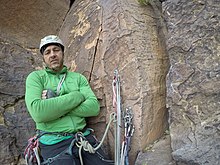
- benightment
- An unplanned overnight bivouac, often due to an epic.[citation needed]
- bergschrund
A crevasse that forms on the upper portion of a glacier where the moving section pulls away from the headwall.
- beta
- Advice, tips, or general information on how to successfully complete (or protect) a particular climbing route, boulder problem, or crux sequence. Some climbing purists believe that obtaining beta prior to attempting a route "taints" an ascent.
- beta break
- In sport climbing, a move on a route other than the move originally intended by the route setter.
- beta flash
- The clean ascent of a climb on the first attempt, having previously obtained beta or while having beta shouted up from the ground en route. Also see on-sight.
- bicycle
- A technique used to keep the feet on when climbing on overhangs. One foot is placed on a foothold and the other foot is placed behind the foothold in a toe hook position. The climber can now squeeze the hold between the feet.
- bidoigt
- (French for "two fingers") A climbing hold, typically a pocket or hueco, that has enough room for two fingers. See also mono.
- big wall
- Any climb on which most climbing parties will spend more than one day. "Big wall style" generally refers to hauling the needed gear (food, water, sleeping bags) in a haul bag (rather than carrying the gear on one's person) and raising the haul bag between pitches.
- biner
- See carabiner.
- bivouac
A camp, or the act of camping, overnight while still on a climbing route off the ground. May involve nothing more than lying down or sitting on a rock ledge without any sleeping gear. When there is no rock ledge available, such as on a sheer vertical wall, a portaledge that hangs from anchors on the wall can be used.
- bivy-bag
- A lightweight garment or sack offering full-body protection from wind and rain, which can be used as a makeshift shelter for a bivouac.
- boinking
- A sports climbing technique to get back onto the wall after falling. Rather than lowering to the ground, the climber pulls on the rope, un-weights, and allows the belayer to take the slack quickly.
- bollard
- A large knob of rock or ice used as a belay anchor.
 Snow bollard
Snow bollard - bolt
- A point of protection permanently installed in a hole drilled into the rock, to which a metal hanger is attached, with a hole for a carabiner or ring.
- bolt chopping
- The deliberate and destructive removal of one or more bolts.
- bomb-proof anchor
A totally secure anchor. "Bomber" can also refer to a particularly solid handhold or foothold (e.g. a "bomber jug").
- book
An inside angle in a rock face. See also dihedral.
- booty
- Gear left behind at a climbing area.
- bosun's chair
- 1. To reduce pains from heavy-duty climbing using a harness, such as long-time belaying or bolting a new route, climbers attach their harness with a special type of chair, which is usually light and has multiple high-endurance straps and buckles. Similar types are also used in industrial climbing.
- 2. Another name for a bowline on a bight, a rescue knot.
- bouldering
- The practice of climbing on large boulders. This type of climbing is done relatively close to the ground, typically less than 20 feet (6.1 m), such that protection takes the form of crash pads and spotting instead of belay ropes, which also obviates the need for bolts and anchors.
- bowline on a bight
- The bowline on a bight is a knot which makes a pair of fixed-size loops in the middle of a rope.[13] Its advantage is that it is reasonably easy to untie after being exposed to load. This knot can replace the figure-eight loop knot when tying into a climbing harness.
- bridging
- See stemming.
- bucket
- A large handhold.
- bumbly
- A novice or otherwise incompetent climber.[14]
- bummer
- A difficult or uncomfortable hold, often one that tears the skin on one's hand.
- bump
- A climbing technique wherein a hand or foot is moved to one hold then quickly moved up immediately to a further hold. This is often done over short distances advancing from an inferior hold to a superior one.
- buildering
- The practice of climbing on buildings, which is often illegal.
- buttress
- A prominent feature that juts out from a rock or mountain.
 Big buttress, Scottish sea coast
Big buttress, Scottish sea coast
C[]
- cam
- A spring-loaded device used as protection.
- camming
- A motion or position where rotation of a piece of equipment or body part presses it tight against a rock, creating friction and holding it in place. As in spring-loaded camming device, heel-toe camming,[15] or knee bar camming.[16]
- campus
- The act of climbing without using the feet.
- campus board
- Training equipment used to build finger strength and strong arm lock-offs.
- chalk bag
- A hand-sized holder for climbing chalk that is usually carried on a chalkbelt or clipped to a harness for easy access during a climb.

- chest jam
- Jamming the torso into a wide crack, especially in order to rest.
- cheese grater
- A sliding fall down a slab style climb.[17]
- chicken head
- See bollard and horn.Tied-off chicken head
- chicken wing
- A crack climbing technique where a hand is placed on one side of the crack and the shoulder on the other.[18]
- chimney
- 1. A rock cleft with mostly parallel vertical sides, and large enough to fit the climber's body into. To climb such a structure, the climber often uses their head, back, and feet to apply pressure on the opposing faces of the vertical walls.
- 2. The process of using such a technique (chimneying).
- chipping
- Improving a hold by permanently altering the rock, which is considered unethical and unacceptable.
- chock
A naturally occurring stone wedged in a crack.
- choss
- Loose or "rotten" rock that makes for unpleasant, difficult, or dangerous climbing.
- classification
- See grade.
- clawing
- Use of the front points of crampons, the pick of an ice axe, and/or an ice hammer pick to climb a snowy or icy slope.
- clean
- 1. To remove equipment from a route.
- 2. A route that is free of loose vegetation and rocks.
- 3. To complete a climb without falling or resting on the rope. See also redpoint.
- 4. In aid climbing, abbreviated "C", a route that does not require the use of a hammer or any invasive addition of protection (such as pitons or copperheads) into the rock.
- cleaning tool
-
A device for removing jammed equipment, especially nuts, from a route.
- climbing area
- A region with numerous climbing routes.
- climbing command
- A short phrase used for communication between a climber and a belayer.
- climbing gym
- A specialized indoor climbing center. Usually just called a "climbing wall" in the UK. See gym climbing.
- climbing shoe
- A special type of footwear designed specifically for climbing. Usually well-fitting, with thick, strongly gripping rubber soles.
- climbing technique
- A particular technique or movement commonly applied in climbing.
- climbing wall
- Artificial rock, typically in a climbing gym.
- clipping in
- The process of attaching to belay lines or anchors for protection.
- clipstick
- See stick clip.
- col
- A small pass or "saddle" between two peaks. Excellent for navigation, as when standing on one it is always down in two, opposite, directions and up in the two directions in between those.
- cold shuts
- Industrial hardware used to link or repair steel chains, occasionally adapted by climbers as rappel anchors.[19] Cold shuts can be either open, shut or welded. Open cold shuts are the unaltered hardware, which is hammered closed and sometimes welded, resulting in more secure anchors.[20]
- contact strength
- The ability of a climber to grip a hold on first contact from a dynamic move.
- copperhead
- A small nut with a head made of soft metal on a loop of wire.
- cord lock
- A lock or toggle used to fasten cords with gloved hands. Used on most mountaineering gear.
- cordelette
- A long loop of accessory cord used to tie into multiple anchor points.
- corner
- An inside corner of rock, the opposite of an arête (UK). See dihedral.
- cornice
- An overhanging edge of snow on a ridge.
- cowbell
- Another name for a hexcentric, due to the noise they make when hung together on a harness.
- crack climbing
- To ascend on a rock wall by wedging body parts into natural cracks in the rock, i.e. not face climbing. See jamming and chimney.
- crag
- A small area with climbing routes, often just a small cliff face or a few boulders.
- crampons
- A pair of metal frameworks with spikes attached to boots to increase safety on snow and ice.
- cramponing
- 1. Using crampons to ascend or descend on ice, preferably with the maximum number of points of the crampon into the ice for weight distribution.
- 2. Accidentally piercing something with a crampon spike.
- crank
- To pull on a hold as hard as possible.
- crash pad
- A thick mat used to soften landings or to cover hazardous objects in the event of a fall, especially in bouldering. See also bouldering mat.
- crater
Hitting the ground at the end of a fall instead of being caught by the rope.
- crimp
-
1. A hold which is only just big enough to be grasped with the tips of the fingers.[10]
- 2. The process of holding onto a crimp.
- crux
- The most difficult portion of a climb.
- cup
- A hand grip which is squeezed over the top or around the side, between the fingers and palm, forming a cup shape with the hand, or applying this type of hold on any protrusion or feature. More commonly known as guppy.
- cut-loose
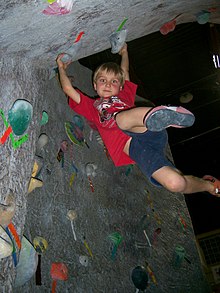 Cut-loose or cutting feet can often result in a large swing
Cut-loose or cutting feet can often result in a large swingWhere a climber's feet swing away from the rock on overhanging terrain, leaving the climber hanging only by their hands.
- cwm
- A hanging valley or cirque—a steep-walled semicircular basin in a mountain—sometimes containing a lake; also known as a corrie.
D[]
- dab
- A term in bouldering for accidentally touching the ground, crash pad, spotter, or another route which might have helped the climber while trying to ascend a particular route, instances of which are typically prohibited.[21][22]
- daisy chain
- A special-purpose type of sling with multiple sewn or tied loops, used in aid and big wall climbing. It is designed to hold a climber's body weight, rather than to arrest a fall, and while the sling as a whole will have a strength rating comparable to that of a standard sling, the individual side loops (pockets) will typically have much lower ratings. This is because a load between the two strength ratings could cause the pocket stitching to break, allowing the attachment device, typically a carabiner, to slide to the end of the sling before being halted by the greater strength of the webbing material itself.
- dead hang
- To hang limp, such that weight is held by ligament tension rather than by muscles.
- deadman anchor
- An object which lies horizontally and[23] is buried in the snow to serve as an anchor for an attached rope. One object often used is a snow fluke.
- deadpoint
- A controlled dynamic motion in which the hold is grabbed with one hand at the apex of upward motion of the body, while one or both feet and the other hand maintain contact with the rock.[24] Dynamic motions in which both feet leave the rock are typically called dynos.
- deck
- 1. The ground below a climbing route.
- 2. To hit the ground, usually as the outcome of a fall.
- deep-water soloing (DWS)
- Free climbing an area that overhangs a deep enough body of water to allow for a safe fall. Also known as psicobloc.
- descender
A device that enables a controlled descent on a rope. Many belay devices may be used as descenders, including ATCs, figure eights, and carabiners. See rappel.
- dexamethasone
A pharmaceutical drug used in the treatment of high-altitude cerebral edema (HACE) as well as high-altitude pulmonary edema (HAPE). It is commonly carried on mountaineering expeditions to help climbers deal with altitude sickness.[25]
- dialled
- To have a complete understanding of a particular climbing move or route.
- Diamox
- A drug used to inhibit the onset of altitude sickness. Otherwise known as acetazolamide.[25]
- dièdre
- A dihedral.[26]
- dihedral
- An inside corner of rock with more than a 90-degree angle between the faces. See also corner and arête.
 dihedral
dihedral - direct aid
- See aid climbing.
- dirtbag
- A climber who lives modestly and often itinerantly, supporting themself through odd jobs in order to maximize the amount of time climbing. Well known practitioners of this lifestyle include Jan and Herb Conn and Fred Beckey.[citation needed]
- double ropes
 Climbers using double rope technique
Climbers using double rope techniqueAny system in which the climber uses two thin ropes instead of one thicker one. Double ropes are often used by trad and alpine climbers. They help manage the rope drag, reduce the chances for accidental cutting of the rope by sharp rock edges, and allow full-pitch rappelling. Unlike twin ropes, double ropes can be clipped separately into different pieces.[27]
- double rope technique (DRT)
- The use of double ropes.
- doubled rope technique (DdRT)
- A method used primarily by tree climbers in which the rope passes over a support/limb and continuously slides over the limb as the climber ascends or descends.
- downclimb
- To descend by climbing downward (rather than by rappelling), typically after completing a climb.
- dropknee
- See Egyptian.[9]
- drag
Rope drag occurs when the friction generated from the rope running over the rock and through the quickdraws builds up to the point where it is difficult to move or pull up the rope to clip into protection. There are several ways to prevent rope drag: protection placement that minimizes zig-zagging of the rope and potential for rope being pinched or hooked on a rock, use of long quickdraws like 24-inch alpine draws, and use of double ropes.[28][29]
- drilled baby angle
 Old drilled baby angle in sandstone
Old drilled baby angle in sandstoneA type of anchor sometimes used in sandstone or other soft rock as an alternative to bolts. The anchor consists of a "baby angle" (piton) hammered into a drilled hole, which some climbers believe is stronger in soft rock than expansion bolts, which can crack the rock. They were especially popular on desert routes in the United States and can be still found on many routes.[30][31]
- drive-by
- A deadpoint where one of the climber's arms crosses over the other to reach a hold that is typically above and to the side.
- dry fire
- One or both hands blows off a hold, often resulting in knuckles painfully striking the rock.
- dry-tooling
- The use of tools designed for ice climbing, such as crampons and ice axes, on bare rock, i.e. not on ice.
- Dülfersitz
- A method of rappelling which does not make use of mechanical tools, whereby the uphill rope is straddled by the climber then looped around a hip, across the chest, over the opposite (weak) shoulder, and held with the downhill (strong) hand to adjust the shoulder friction and thus the descending speed.
- dynamic belay
- Technique of stopping a long fall using smooth braking to reduce stress on the protection points and avoid unnecessary trauma from an abrupt stop.
- dynamic rope
- A slightly elastic rope that softens falls to some extent. Also tends to be damaged less severely by heavy loads. Compare static rope.
- dynamic motion
- Any move in which a climber makes use of their body momentum in order to grab a hold that would otherwise be out of reach, as opposed to static technique where three-point suspension and slow, controlled movement is the rule. When both feet leave the rock, it is called a dyno. When one or both feet maintain contact with the rock, it is called a deadpoint.
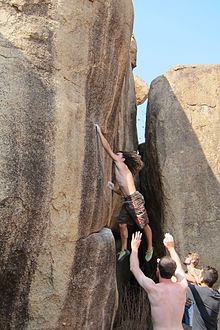 Dynamic motion: body momentum allows the climber to grab a hold that would otherwise be out of reach
Dynamic motion: body momentum allows the climber to grab a hold that would otherwise be out of reach - dyno
- A jump or leap in which both feet leave the rock face and return again once the target hold is caught.Preparing for a dyno
E[]
- edge
- A narrow ledge on a rock wall.
- edging
- Using the edge of a climbing shoe on a foothold. In the absence of footholds, smearing is used.
- Egyptian
-
A method for reducing muscle strain in arms when holding a side grip. One knee ends up in a lower position with the body twisted towards the other leg. It can give a longer reach as the body and shoulders twist towards a hold.[citation needed]
- Egyptian bridging
- The same position as bridging or chimneying, but with one leg in front and one behind the body.
- eight-thousander
- A mountain whose summit elevation exceeds 8,000 meters (26,247 ft) above sea level.
- eliminate
- A bouldering move or series of moves in which either certain holds are placed "off bounds" or other artificial restrictions are imposed.
- Elvis legs
- Wobbly knees resulting from tired legs. See sewing-machine leg.
- epic
- An otherwise ordinary climb rendered difficult by a dangerous combination of weather, injuries, darkness, lack of preparedness, or other adverse factors. See punter.
- ERNEST
- An acronym which stands for Equalised, Redundant, No Extension, Strong, and Timely, the important points to consider when building anchors. See also SERENE.
- etrier
- A webbing ladder for aid climbing.[32]
- European death knot (EDK)
- A flat overhand used to join a pair of ropes for retrievable abseils. So named as the technique originated in Europe, and American climbers initially distrusted it.
- exposure
- A measure of the amount of empty space below or around a climber, usually referring to a great distance between a climber and the ground or some other perceptibly safe and stable area such as a large ledge, or to the psychological impact of this distance due to being unprotected, or because the rock angles away when climbing an arête or overhang.
- extreme
- Part of the UK adjectival grading system, originally short for extremely / exceptionally severe (XS); now split numerically into E1, E2, etc.
F[]
- face climbing
- Any climbing that involves ascending a vertical rock face using finger holds, edges, and smears, as opposed to crack climbing.
- feet follow
- An instruction on indoor bouldering routes requiring that foot movements match preceding hand movements, with no intermediate moves.
- feature
- A protrusion or indentation on an indoor climbing wall which is permanently moulded into the wall itself.
- Via ferrata
A route on a mountain where the safety is provided by steel ropes or chains that are permanently fixed to the rock. The progression is often aided by artificial steps or ladders. Typically found in the Alps.
- figure four
- An advanced climbing technique in which the climber hooks a leg over the opposite arm, and then pushes down with this leg to achieve a greater vertical reach. Requires strength and a solid handhold.
- figure eight
- A belay device or descender that is shaped like the number eight.[10]
- figure-eight knot
-
A knot commonly used to secure a climber's harness to the climbing rope.
- finger jam
A type of jam using the finger.
- finger board
- Training equipment used to build finger strength. See also hangboard.
- first ascensionist
- The person who performed the first ascent of a particular route, rock face, or mountain.
- first ascent (FA)
- The first successful completion of a particular route, or the first successful attempt to reach the top of a particular rock face or the summit of a particular mountain.
- first free ascent (FFA)
- The first ascent of a particular route, rock face, or mountain achieved without aid.
- fist jam
- A type of jam using the hand.
- fixed rope
- A rope which has a fixed attachment point. Commonly used for abseiling or aid climbing.
- flagging
- A climbing technique in which a leg is held in a position to maintain balance, rather than to support weight. Such positions are often useful in preventing barn-dooring. There are three types of flagging:
- Normal flag
- When the flagging foot stays on the same side (e.g. flagging with the right foot out to the right side of the body).
- Reverse inside flag
- When the flagging foot is crossed in front of the foot that is on a foothold.
- Reverse outside flag
- When the flagging foot is crossed behind the foot that is on a foothold.[10][9]
- flake
- 1. A thin slab of rock detached from the main face.
- 2. A method of untangling a rope in which the rope is run through the climber's hands and allowed to fall into a pile on the ground. Useful when preparing a rope for coiling, or before starting a lead climb, to ensure the rope is fed cleanly and without twists. Often called "flaking out" a rope.
- flapper
- An injury consisting of a piece of loose (flapping) skin. A climber will usually just repair these with sticky tape or super glue.
- flash
- To successfully and cleanly complete a climbing route on the first attempt after having received beta of some form. Also refers to an ascent of this type. For ascents on the first attempt without receiving beta, see on-sight.
- flat-lander
- A non-climber.
- flute
- A usually insecure fin or flake of rock or ice.
- font
- The French bouldering grading system.
- foot jam
A technique involving jamming the foot into a larger crack by twisting the foot into place, the contact with the crack being on the heel and toes.
- fourteener
- A mountain summit that exceeds 14,000 feet (4,300 m), particularly one in the contiguous United States.
- free base
- Climbing with your only protection being a parachute that is deployed in the event of a fall. It is a combination of free soloing and BASE jumping.
- free climbing
- Climbing without unnatural aids, other than those used for protection.
- free solo climbing
Climbing without any type of aid or protection. This typically means climbing without a rope.
- French free
The use of aid climbing techniques to bypass a section due to climbing difficulty, rock conditions, etc.; typically for only a short section of the total climb.[33]
- Frenchies
- An exercise used to develop lock-off strength consisting of pull-ups that stop with the elbows locked at angles between 20 and 160 degrees.
- friable
- Delicate and easily broken, as of rock, often dangerously so.
- friction
- A climbing technique relying on the friction between the sloped rock and the sole of the shoe to support the climber's weight, as opposed to using holds or edges, cracks, etc.
- Friend
- A name brand of a type of spring-loaded camming device (SLCD) made by Wild Country, sometimes used to refer to any type of spring-loaded camming device.
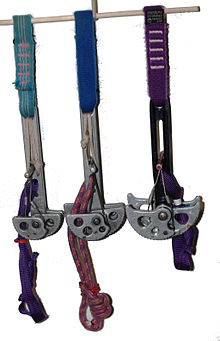 Early Wild Country rigid Friends
Early Wild Country rigid Friends
G[]
- Gaston
- A climbing grip using one hand with the thumb down and elbow out, often thought of as a reverse side pull. The grip maintains friction against a hold by pressing outward toward the elbow. Named for French climber Gaston Rébuffat.[9]
- gate flutter
- The action of the gate on a carabiner opening during a fall.
- gendarme
- A pinnacle or isolated rock tower frequently encountered along a ridge.
- Geneva rappel
- A modified Dulfersitz rappel using the hip and downhill arm for friction, rather than the chest and shoulder, offering less complexity, but less friction and less control. Geneva style is also a description used in Australia for what is commonly referred to elsewhere as Australian rappelling.
- glacier travel
- Walking or climbing on a glacier; a rope is usually used to arrest falls into crevasses, but protection is generally not used.
- glissade
- A usually voluntary act of sliding down a steep slope of snow.
- golden retriever
- When a climber is cleaning a route and forgets to pull out a piece or unclip the rope and begins to climb above the piece, rendering the top rope ineffective.
- gorp
- Trail mix for periodic nibbling to maintain energy levels between meals on long climbs or hikes. The name comes from "Good Old Raisins and Peanuts."[34]
- grade
- Any classification intended as an objective measure of the technical difficulty of a particular route or bouldering problem. Numerous and often conflicting grading systems exist, and grades for individual routes are often highly subjective.
- green point
- Climbing a sport route with the use of traditional gear.
- Grigri
- A belay device invented and manufactured by Petzl and designed to increase the ease with which falls can be arrested, especially for heavier climbers or longer falls, because it makes use of assisted braking under load.
- gronked
- Having accidentally gone off-route while leading and become lost on a rock face in an area much more difficult than the intended climb. The word arises from the climb "Gronk" in Avon Gorge, which is notorious for this.
- Gumby
- A new climber (derogatory). Originates in the 1950s in reference to the claymation character Gumby's bumbling style of movement.[35]
- guppy
- A synonym for cup, commonly used in bouldering.
- gym climbing
Climbing indoors on artificial climbing walls.
H[]
- hand jam
- Making progress by inserting the hand (usually vertically with the thumb uppermost) into a crack and then pushing the thumb downwards towards the palm. This expands the hand and can make a highly secure placement. In the UK this move was credited with facilitating the advances in free climbing in the late 1940s and 1950s made by climbers such as Joe Brown and Don Whillans, although they did not invent it.
- hand traverse
- Traversing without any definitive footholds, i.e. smearing or heelhooking.
- hangdog
- While lead climbing or on top rope, to hang on the rope or a piece of protection for a rest.
- hanging belay
- Belaying at a point such that the belayer is suspended.
- high-altitude cerebral edema (HACE)
- A severe and often fatal form of altitude sickness caused by extended periods of physical exertion without sufficient oxygen.[25]
- high-altitude pulmonary edema (HAPE)
- A severe form of altitude sickness caused by extended periods of physical exertion without sufficient oxygen.[25]
- harness
- A sewn nylon webbing device worn around the waist and thighs that is designed to allow a person to safely hang suspended in the air.
- haul bag
- A large and often unwieldy bag bag into which supplies and climbing equipment may be thrown to transport gear up long multi-pitch climbs (e.g., big walls). Typically ruggedized to withstand being dragged up and over rock and ice by a pully system.
 A haul bag
A haul bag - headpoint
- The practice of top-roping a hard trad route before leading it cleanly.
- headwall
- A region at the top of a cliff or rock face that steepens dramatically.
- heel hook
- Using the back of the heel to apply pressure to a hold for balance or leverage; this technique requires pulling with the heel of the foot by flexing the hamstring. This technique is notable since in most forms of climbing one uses the toes to push.[10]
- heel-toe
A combination of a toe hook and heel hook. It involves using opposing pressure from the toes and heel between two holds to hold the body on the wall.
- hexcentric
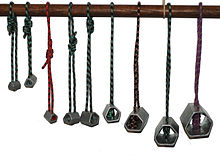 A set of hexes.
A set of hexes.A protective device consisting of an eccentric hexagonal nut attached to a wire loop. The nut is inserted into a crack and it holds through counter-pressure.
- high ball
- A tall boulder problem. Falling becomes more dangerous due to the increase in height.
- Himalaism
- A style of climbing developed in the Himalayas. In a broader sense this is Himalayan mountaineering, similar to the nature of climbing in the Himalayas, but also grown in other high mountains, where the altitudes of many peaks exceed 7,000 metres (23,000 ft) above sea level, including the Karakoram, Kunlun, Hindu Kush, Pamir, Tian Shan, and Daxue Shan.
- hip belay
- A method of belaying, whereby the friction against the rope is increased by passing the rope around the hip or waist of the belayer.
- hold
- A place to temporarily cling, grip, jam, press, or stand in the process of climbing.
- HMS carabiner
- A round-ended carabiner for use with a Munter hitch (from the German name for the hitch; Halbmastwurfsicherung).
- honed
- To be in peak mental and physical fitness for climbing.
- hook
- 1. Equipment used in aid climbing.
- 2. A climbing technique involving hooking a heel or toe against a hold in order to balance or to provide additional support.
- horn
- A large, pointed protrusion of rock that can be slung. Typically also makes a good handhold. Known in the UK as a spike. See bollard and chicken head.
- hueco
- (From Spanish hueco, meaning "hole") A climbing hold consisting of a pocket in the rock, typically round and deep and featuring a positive lip. Huecos vary in size from accommodating a single finger (this is also called a "mono") to large enough to fit one's entire body. The term hueco entered the jargon of rock climbers from the Texas climbing area Hueco Tanks that is famous for this sort of hold.
I[]
- ice hammer
- A lightweight ice axe with a hammer and pick head on a short handle and no spike.
- ice piton
- A long, wide, serrated piton once used for weak protection on ice.
- ice screw
- A screw used to protect a climb over steep ice or for setting up a crevasse rescue system. The strongest and most reliable is the modern tubular ice screw which ranges in length from 10 to 23 centimetres (3.9 to 9.1 in).[36]
- ice tool
- A specialized elaboration of the modern ice axe (and often described broadly as an ice axe or technical axe), used in ice climbing, mostly for the more difficult configurations.
- indoor climbing
- See gym climbing.
J[]
- jamming
- Wedging a body part into a crack.
 Hand jamming
Hand jamming - jib
- A particularly small foothold, usually only large enough for the big toe, sometimes relying heavily on friction to support weight.
- jug
- A shortened term for jug hold, both noun and verb.
- jug hold
A large, easily held hold.
- jumar
- 1. A type of mechanical ascender.
- 2. To ascend a rope using a mechanical ascender.
K[]
- Klemheist knot
- An alternative to the Prusik knot, useful when the climber is short of cord but has plenty of webbing.
- knee bar
- Knee bar used in bouldering
Involves camming the lower thigh or knee against a protruding section of rock, usually with the foot pushing against an opposing hold. Knee bars can be very secure and are one of a few ways to get a no-hand rest on overhanging rock. They also can provide additional hold on a climb.[16][37]
- knee drop
- See Egyptian.
L[]
- laybacking
-
Climbing a vertical edge by side-pulling the edge with both hands and relying on friction or very small holds for the feet.[9]
- lead climbing
- A form of climbing in which the climber clips the belay rope into quickdraws or similar equipment attached to the wall by means of anchors. In traditional climbing, the climber needs to place the anchors and quickdraws; in sport climbing, the anchors are typically already in place, and the quickdraws may either be pre-placed or placed by the climber.
- leader fall
- A fall while lead climbing or from above the climber's last piece of protection. The falling leader will fall at least twice the distance back to their last piece, plus slack and rope stretch.
- leashless
- Ice climbing with axes not being attached to the wrist, such that if dropped they are gone. The trade-off is greater mobility.
- Leavittation
- A technique used to climb off-width cracks pioneered by Randy Leavitt and Tony Yaniro. It uses alternating hand-fist stacks and leg-calf locks.
- A mechanical piece of climbing equipment that can be attached to a belaying device to improve safety for the climber and stability for the belayer.
- liquid chalk
- A liquid form of climbing chalk with a longer hold time than normal chalk. It is used on very hard routes and competitions, where the act of re-chalking requires too much energy or time.
- lock-off
- Fully bending one's arms and using tendon strength to support weight on a handhold without overly tiring muscles. Contrast with dead hang.
- lolotte (French)
- Placement of a leg with a knee turned downwards (heel upwards). Allows the climber to enhance a high or vertical foothold, and bring the body closer to the wall. This term comes from (nicknamed "Lolo") who invented this movement.
- low-angle
- A face climb that is less than vertical; the opposite of an overhang or roof. The same as "slab".
M[]
- mantel
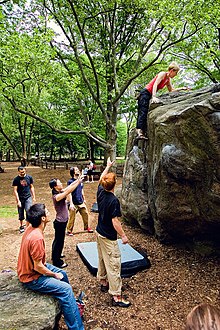 Mantel move
Mantel moveA move used to surmount a ledge or feature in the rock in the absence of any useful holds directly above. It involves pushing down on a ledge or feature instead of pulling oneself up. In ice climbing, manteling is done by moving the hands from the shaft to the top of the ice tool and pushing down on the head of the tool. Abbreviation of mantelshelf.[10][9]
- mantle
- The external covering of a climbing rope. Climbing ropes use kernmantle construction consisting of a kern (or core) for strength and an external sheath called the mantle.
- match
- To use one hold for two limbs.
- merkel
- To retrieve another climber's gear because they are unable to or because it would be more convenient.
- moat
- A crevasse that forms where the glacier pulls away from a rock formation.
- mono
- (French monodoigt, meaning "single finger") A climbing hold, typically a pocket or hueco, that only has enough room for one finger.
- moving together
- A method of climbing used on easy alpine ground in which two or more climbers climb at the same time with running belays between them and fixed belays not being used. Similar to simulclimbing, a technique for steeper terrain.
- multi-pitch climbing
- Any climbing done on routes that are too long for a single belay rope, and hence consist of multiple pitches which must be belayed separately.
 Climber a few pitches up on a multi-pitch climb
Climber a few pitches up on a multi-pitch climb - Munter hitch
A simple hitch that is often used for belaying without a mechanical belay device.
N[]
- naturals
- In a climbing gym, the natural features of the wall texture itself, i.e. those which can be climbed on but are not bolt-on holds.[38][39]
- névé
- Permanent granular ice formed by repeated freeze-thaw cycles.
- no-hand rest
- An entirely leg-supported resting position during climbing that does not require hands on the rock.
- nub
- A little hold that only a few fingers can grip, or the tips of the toes.
- nunatak
- A mountain or rock that protrudes through an ice field.
- nut
- A metal wedge attached to a wire loop that is inserted into cracks for protection. See hexcentric.
 Large rack of assorted nuts
Large rack of assorted nuts - nut key
See cleaning tool.
O[]
- objective danger
- Danger in a climbing situation which comes from hazards inherent in the location of the climb, not depending on the climber's skill level. Most often these involve falling rock or ice, or avalanches.
- off belay
- Called out by a climber when requesting that the belayer remove belay equipment from the climbing rope (e.g. when cleaning top protection from a lead route). Replied to with "belay off".
- off-width
- A crack that is too wide for effective hand or foot jams but is not as large as a chimney.
 Off-width climbing
Off-width climbing - on belay
- What an American climber calls when they are ready to be belayed. Replied to with "belay on".
- on-sight
- A clean ascent made on the first attempt without prior practice or beta. For ascents on the first attempt with beta, see flash.
- open book
- An inside angle in the rock. See also dihedral.
- overhang
- A section of rock or ice that is angled beyond vertical. See roof.
- orangutan
- A position in which one's back is facing the wall and has a posture resembling an orangutan hanging with limbs outstretched. The orangutan is primarily used for horizontal traversal. In a left traversal, the sequence starts by threading one's right foot and right hand between the placements of one's left foot and left hand to reach the next supportive rock features. The exit sequence is symmetric.
P[]
- peak-bagging
- To systematically attain designated summits under prescribed conditions.
- peel
- To fall.
- peg
- A piton.
- pendulum
- 1. Swinging on taut rope to reach the next hold in a pendulum traverse.
- 2. A swing during a fall when the last piece of protection is far to one side.
- personal anchor system (PAS)
- An adjustable attachment point from climber to anchor which allows for building anchors, cleaning routes, and rappelling to be done quickly and efficiently.
- picket
- A long, tubular rod driven into snow to provide a quick anchor.
- pied à main (French)
- A movement where the foot is placed on the same hold as the hand.
- pied à plat (French)
- A crampon technique in the French style: to climb on high-angle ice with feet flat on the ice (as opposed to front-pointing).
- pied assis (French)
- A crampon technique in the French style: to rest on high-angle ice with one foot tucked under the buttocks, toes pointed straight down-slope.
- pied d'elephant (French)
- A short, light sleeping bag covering the lower half of the body only. It is designed to be used in connection with a down jacket for lightweight bivvies.
- pied en canard (French)
- A crampon technique in the French style: to walk on moderate-angle ice with toes pointed outward; literally, "duck-footed".
- pied marche (French)
- A crampon technique in the French style: to walk on low-angle ice with toes pointed straight ahead.
- picknick stop
- A no-hand rest.
- pinch hold
- This is a hold that must be pinched to hold on. They come in various sizes.[10]
- pinkpoint
- To complete a traditional lead climb without falling or resting on the rope (hangdogging), but with pre-placed protection and carabiners. See also clean and redpoint.
- pitch
- The portion of a climb between two belay points. A "full pitch" is the same height as the length of one's rope: 50–60 metres (160–200 ft).
- piton
- A flat or angled metal blade of steel which incorporates a clipping hole for a carabiner or a ring in its body. Pitons are typically used in aid climbing, where an appropriate size and shape is hammered into a thin crack in the rock and preferably removed by the last team member.
 A piton
A piton - piton catcher
- A clip-on string fastened to a piton when inserting or removing, so as to avoid loss.
- plunge step
- An aggressive step pattern for descending on hard or steep-angle snow.
- pof
- An alternative to climbing chalk that is made from pine resin. Popular in Fontainebleau but discouraged (or actively forbidden) everywhere else since it deposits a thick, shiny resin layer on the rock and friction can only be achieved by using more pof.
- polish
- On popular routes, the passage of heavy traffic can wear the rock to such an extent that it loses some of its natural friction, making climbing much more difficult. This is often most noticeable at the crux, and more common on certain rock types.
- poop tube
- A container for carrying out feces during multi-day climbs. The poop tube is made of PVC tubing, with a sealed end at the bottom and a screw top. It has a loop attaching screw top to the body of the tube and typically a webbing so it can be clipped below a haul bag.[40][41]
- positive
- A hold or part of a hold with a surface facing upwards, or away from the direction it is pulled, facilitating use. A positive hold is the opposite of a sloper.
- pressure breathing
Forcefully exhaling to facilitate O2/CO2 exchange at altitude.
- problem
In bouldering, the path that a climber takes in order to complete a climb; used equivalently to route in roped climbing.
- project
- 1. A potential new route or bouldering problem that is being attempted but has not yet seen a first ascent.
- 2. An established route or bouldering problem that an individual is repeatedly attempting to ascend over a period of time but which has not been successfully sent by that climber. Sometimes slang in the form proj.
- protection
- 1. The process of setting equipment or anchors for safety.
- 2. Equipment or anchors used for arresting falls.
- Prusik
- 1. A knot used for ascending a rope. It is named after Austrian mountaineer Karl Prusik, who developed this knot in 1931.
- 2. To use a Prusik knot for ascending a rope.
- pseudo leading
To climb a wall toprope with having another rope connected to the climber, for practice of lead climbing clipping. The other rope is normally not connected to any belayer below and is only there to practice the clipping. Usually practiced while learning how to lead climb.
- psychological protection
- A piece of protection that everyone knows will not actually hold a fall but which makes the climber feel better about having gear beneath them.
- pumped
- To have such an accumulation of metabolic waste products in the forearm, that forming even a basic grip becomes impossible. A climber who is pumped will find it difficult to hold on, and may struggle to lift or clip a rope.
- punter
- An overambitious and underprepared climber.
- psyched
- To be excited for climbing or a particular climb.
Q[]
- quickdraw
Used to attach a freely running rope to anchors or chocks.
- quicklink
A screw-type oval-shape stainless steel carabiner which is smaller than a normal oval-shape biner, particularly one used for attaching to the chains of the master anchor.
R[]
- rack
- 1. The set of equipment carried up a climb.
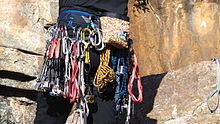 Trad rack
Trad rack - 2. The part of a harness (consisting of several plastic loops) where equipment is hung, ready to be used.
- 3. A type of descender consisting of bars mounted on a "U"-shaped chassis.
- rappel
The process by which a climber descends a fixed rope using a friction device.
- RB
- A removable bolt, similar in concept to a sliding nut, but shaped to fit into a drilled hole.
- rebolting
- The replacement of bolts on an existing climb.
- redpoint
- Free climbing by leading after having practiced the route beforehand (either by hangdogging or top roping). See also clean and pinkpoint.
- rest step
- An energy-saving climbing technique where the unweighted (uphill) leg is rested between each forward step, sometimes by "locking" the knee of the rear leg.
- retro-bolting
- The addition of bolts to an existing climb which has already been ascended using natural protection.
- rodeo clipping
- To clip into the first piece of protection from the ground by swinging a loop of rope so that it is caught by a carabiner. This can only be done when the first piece of gear is already placed.
- roof
- A steep overhang which transitions sharply into shallower climbing often blocking direct sight of the feet causing the climber to find footholds blindly.
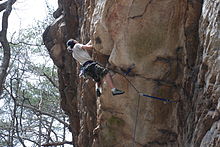 Climbing over a roof
Climbing over a roof - rope jumping
- Jumping from objects using rock climbing equipment.
- rope team
A team of mountaineers or climbers joined together by a safety rope.
- rose
An extreme cross-through reach in which the crossing arm goes behind the other arm and is so far extended that the body is forced to twist until it ends up facing away from the rock. It was introduced by Antoine Le Menestrel, who used it to climb a route in Buoux, called La rose et le vampire.[43][35]
- route-read
Looking at a problem to determine the beta before starting it.
- RP
- A small nut, named after . Not certified for sale in Europe.
- runner
- 1. In the US, a sling made of nylon and nylon/blend materials, used by climbers for a multitude of purposes.
- 2. In the UK, any item of gear placed by the lead climber to reduce the length of a fall. Also called a running belay.
- runout
- 1. A long portion of a route with minimal protection.
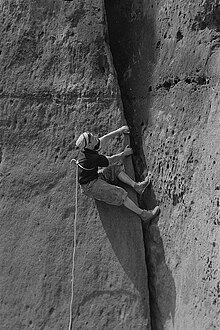 A runout
A runout - 2. A lengthy distance between two points of protection which in some, but not all, cases might be perceived as frightening or dangerous. May also be used as an adjective to describe a route or a section of a route.
- RURP
- A miniature, postage stamp-sized piton originally designed by Yvon Chouinard. An acronym for realized ultimate reality piton.
S[]
- saddle
- A high pass between two peaks, larger than a col.
- sandbag
- A climb which receives a much lower grade than deserved. Also used as a verb when referring to the act of describing a climbing route as easier than it actually is.
- Sardar
Head Sherpa mountain guide.
- 'scend
- A contraction of the word ascend, past tense 'scended. See also send.
- scrambling
- A type of climbing somewhere between hiking and graded rock climbing.
- screamer
- A nylon webbing structure consisting of one large loop sewn in multiple places to make a shorter length. The stitch-points are intentionally sewn with less than maximum possible strength. The screamer is attached with carabiners between an anchor point, particularly one of dubious strength, and the climber. In the event of a fall the stitching of the sewn sections is designed to rip apart, absorbing some of the fall energy and decelerating the climber, thereby reducing the overall shock load on the dubious anchor. Screamer is a brand name of Yates Mountaineering.
- scree
- Small, loose, broken rocks, often at the base of a cliff; also any area or slope covered in such rocks. Scree is distinguished from talus by its smaller size and looser configuration.
- screw on
A small climbing hold screwed onto the wall in a climbing gym. Can be used for feet in a route regardless of its colour.
- second
- A climber who follows the lead, or first, climber.
- self-arrest
- The act of planting the pick of an ice axe into the snow to arrest a fall in the event of a slip. Also a method of stopping in a controlled glissade.
- send
- To cleanly complete a route, i.e. on-sight, flash, or redpoint. See also 'scend.
- serac
- A large tower of ice on the surface of a glacier.
- SERENE
- An acronym for the important points to consider when building anchors. The acronym stands for Strong, Equalised, Redundant, Efficient, No Extension. See also ERNEST.
- sewing-machine leg
The involuntary vibration of one or both legs resulting from fatigue or panic. Can often be remedied by bringing the heel of the offending leg down, changing the muscles used to support the weight of the climber.
- shadow match
- to quickly switch hands on a hold you can only fit one hand on at a time.
- sharp end
- The end of the belay rope that is attached to the lead climber. "Being on the sharp end" refers to the act of lead climbing, which is considered more psychologically demanding than top-roping or following, since it may involve more route-finding, as well as the possibility of longer, more consequential falls.
- Sherpa
- A person of the ethnic group of the same name that is located in the Himalaya Mountains. Also a generic term for mountaineering porters in Nepal (usually those working at or above base camp), regardless of their ethnic group.
- short fixing
- A traditionally belayed lead climber reaches a new belay station and creates an anchor, tying the lead rope off to the anchor. The climber then switches over to self-belaying and continues to climb. Meanwhile, the second climber ascends the fixed rope using ascenders (a.k.a. "jugging") and cleans the pitch. When the second reaches the belay, they anchor in and start to belay the leader in the traditional way again. When the leader reaches the next belay the process is repeated.
- side pull
- A hold that needs to be gripped with a sideways pull towards the body.[9]
- simul climbing
A technique in which two climbers move simultaneously upward, with the leader placing protection which the second removes as they advance. A device known as a Tibloc which allows the rope to only move in a single direction is sometimes used to prevent the second climber from accidentally pulling the lead climber off should the second slip.[44]
- single-rope technique (SRT)
- The use of a single rope where one or both ends of the rope are attached to fixed anchor points.
- sit and spin
- A method of starting a rappel from a cliff edge, accomplished by sitting with legs over the edge and then spinning around to face the cliff while planting feet on the face.
- sit start
- Starting a climb from a position in which the climber is sitting on the floor. This is common in climbing gyms in order to fit an extra move into the climb. Noted as SS or SDS in some topo guides.
- skittling
- Climbing without following any specific color in a gym that uses color-designated routes or problems.
- skyhook
- A small hook which gives hold on small protrusions on watery and slippery grips. Most often used for placements, often extremely marginal, in aid climbing, although they also feature in some extreme free routes. Additionally, a skyhook can be attached to a harness, thus allowing the climber to rest, or held in one or both hands to hold a grip.
- slab
- A relatively low-angle (significantly less than vertical) section of rock, usually with few large features. Requires slab climbing techniques.
- slab climbing
- A type of climbing, and its associated techniques, involved in climbing rock that is less than vertical and devoid of large or secure holds. The emphasis is on balance, footwork, and making use of very small features or rough spots on the rock for friction.
- SLCD
- An abbreviation for spring-loaded camming device, a type of protection device. These are better known by the term cam.
- sloper
- A hold or part of a hold in which the surface slopes down toward the ground, with very little positive surface.[10]Sloper holds
- smearing
- To make use of friction on the sole of the climbing shoe in the absence of any useful footholds.[10]
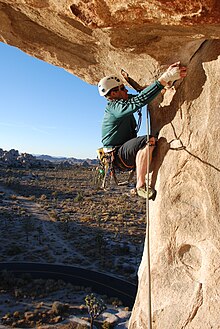 Smearing foothold
Smearing foothold - smedging
- Smearing on an edge, especially on a dime edge or any linear hold that is too small to stand on or use as an ordinary positive hold.
- snarg
- A type of tubular ice screw that is inserted by hammering.
- snow fluke
- An angled aluminium plate attached to a metal cable. The fluke is buried into snow and typically used as a deadman anchor.
- soupy
- A hold that is wet and slimy from water or some other source.
- spinner
- In indoor climbing, a hold that is not secure and spins in place when weight is applied.
- spike
- See horn.
- splitter
- Describes a clean crack with perfectly parallel sides, usually in an otherwise blank face. Generalized to refer to any great climb, happy situation, or even favorable weather.
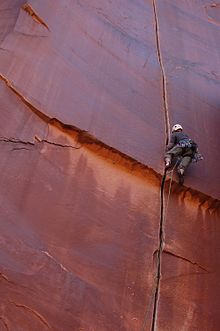 Splitter crack
Splitter crack - sport climbing
- A style of climbing in which form, technical (or gymnastic) ability, and strength are more greatly emphasized over exploration, self-reliance, and the exhilaration of the inherent dangers involved in the sport. Sport climbing routes tend to be well protected with pre-placed bolt-anchors and lend themselves well to competitive climbing.
- spotting
- A method of protection commonly used during bouldering or before the leader has placed a piece of protection. The spotter stands beneath the climber, ready to absorb the energy of a fall and direct them away from any hazards.
- sprag
- A type of hand position where the fingers and thumb are opposed.
- static
- Of a style of climbing or specific move, not dynamic. In general this entails movement of a limb to a new hold without the simultaneous transfer of weight. Instead weight transfer occurs after the limb has moved.
- static rope
- A non-elastic rope. Compare dynamic rope.
- steep
- Descriptive of any climbing face that is angled beyond vertical. See overhang.
- stemming
- 1. The simultaneous use of two widely spaced footholds.
- 2. Climbing using two faces that are at an angle of less than 180° to each other.[10][9]
- step cutting
- Scooping steps out of snow or ice with the adze of an ice axe.
- step kicking
- Scooping and stamping steps out of soft snow with the feet.
- Sticht plate
- A belay device consisting of a flat plate with a pair of slots. Named after the inventor .
- stick clip
- A long stick or extendable pole on the end of which a climber can affix a quickdraw. It allows the climber to clip a quickdraw to the first bolt on a sport climb while still standing on the ground. This is especially useful if the first bolt is high up and out of the climber's comfort zone. A stick clip can be bought, easily made, or even improvised when needed.
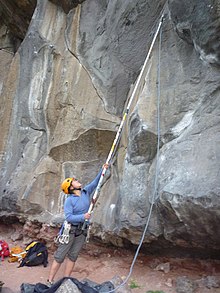 Use of a stick clip
Use of a stick clip - sticky rubber
- Rubber with enhanced frictional properties used on the soles of climbing shoes; originally introduced in the 1980s (on Boreal's Firé shoes) but now ubiquitous.
- stopper
- 1. A wedge-shaped nut made by Black Diamond.
- 2. A knot used to prevent a rope from running through a piece of equipment.
- swami belt
- A kind of proto-climbing harness consisting of a long length of tubular webbing wrapped several times around the climber's body and secured with a water knot. Largely eschewed today in favor of commercial harnesses.

- sweeper
- The last member or the tail of a climbing group. The sweeper's task is to spot and retrieve things that may have accidentally fallen from the preceding climbers; to make sure that no mess or gear is left behind; and to make sure that the rear is keeping up with the whole team. The term sweeper, a Filipino contribution to mountaineering vocabulary, was introduced in 1998 and was inspired by the Cleaner, a character in the 1990 film .
- swinging-lieback
- A dynamic form of the lieback, rotating off one foot while maintaining a grip with one hand, then grabbing a high handhold at the deadpoint of the swing with the other hand. This move is frequently reversible, unlike more aerial dynos.
T[]
- take
- Called out by a climber when requesting that the belayer remove all slack. See hangdogging.
- tak-tak
- Onomatopoeia, a dynamic motion where hands briefly touch a hold one after the other, producing a "tak-tak" sound.
- talus
- An area of large rock fragments on a mountainside that may vary from house-sized to the size of a small backpack. The area, if older and consolidated, may be stable, or the rocks may be precariously balanced. Talus is distinguished from scree in that it is composed of larger rocks and may feature solid interlocking of the rocks, while scree is by definition loose.
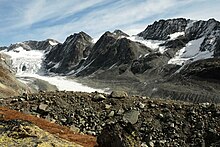 Talus rocks at the foot of a mountain
Talus rocks at the foot of a mountain - teabagging
- When, after a whipper or long fall, a climber falls past their belayer, who is generally lifted up off the ground.
- technical
- A term often used to describe relatively difficult or complex sequences of moves and/or the degree of ingenuity and creativity required to protect a route. Difficulty ratings of climbs are often based on a combination of the perceived technicality of the climb and the endurance or strength necessary to complete it.
- technical climbing
- Climbing involving a rope and some means of protection, particularly as opposed to scrambling or glacier travel (i.e. non-technical climbing).
- technique
- A specialized move given a name to help communicate to another person what to do.
- tendu
- From the French word meaning "outstretched". In this grip the fingers are close to the position when the hand is open. The relative angle between the finger bones is gradual. The load applied is coming from tension in the forearm muscles.
- tension
- A technique for maintaining balance using a taut rope through a point of protection.
- testpiece
- A climb that is representative of the hardest, best climbs in an area.
- thread
- A runner created by threading a sling around a jammed block or through a hole in the rock.
- thrutching
- Making progress by squeezing into a space and wriggling against opposing rock surfaces.
- thumbercling
- A portmanteau of "thumb" and "undercling". A undercling which can only be held with the thumb.
- tie-in points
The leg straps and waist belt of a climbing harness create two loops connecting the belay loop. The points which you tie in at.
- toe hook
- A toe hook is securing the upper side of the toes on a hold.[10] It helps pull the body inwards, towards the wall. The toe hook is often used on overhanging rock where it helps to keep the body from swinging away from the wall.
- top
- The completion of a route. In bouldering, this is when both hands are placed on the top hold. In sports climbing, this is when the last quickdraw is clipped.
- top rope
- To belay from a fixed anchor point above the climb. Top-roping requires easy access to the top of the climb, often by means of a footpath or scrambling.
- top-out
- To complete a route by ascending over the top of the structure being climbed.
- tracking
- See feet follow.
- traditional climbing

A style of climbing that emphasizes the adventure and exploratory nature of climbing. While sport climbing generally makes use of pre-placed protection ("bolts"), traditional (or "trad") climbing involves the placement of one's own protection during the climb, which is generally carried by climbers on a rack.
- training
- Getting prepared to climb on difficult mountains or routes. The Hangboard Repeaters protocol is a common method of training for climbing.[45]
- tramming
A technique that is typically used while lowering and cleaning gear from an overhanging and/or traversing route. A quickdraw is clipped between the climber's harness and the rope that is threaded through the gear. As the climber is lowered by the belayer, the quickdraw holds the cleaner close to the wall and following the line of the route. Without the quickdraw, the climber would lower straight down, further and further from the remaining gear to be cleaned.
- traverse
- 1. Any climbing movement made in a horizontal direction.
 Traverse section on a big wall in Yosemite
Traverse section on a big wall in Yosemite - 2. A section of a route that requires progress in a horizontal direction.
- 3. A Tyrolean traverse is crossing a chasm using a rope anchored at both ends.
- 4. A pendulum traverse involves swinging across a wall or chasm while suspended from a rope affixed above the climber.
- Tricam
- A simple camming protection device that has no moving parts.
- tuber
- A tubular belay device.
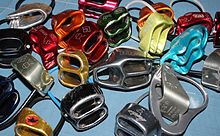 Tubers, or tubular belay devices from different manufacturers
Tubers, or tubular belay devices from different manufacturers - tufa
- 1. A limestone rib formation that protrudes from the wall which can sometimes fit within the pinching grasp of a climber's hand.

- 2. A plastic, bolted-on bouldering hold designed to replicate such a formation on an indoor climbing wall.
- twin ropes
- A system in which the climber uses two thin ropes instead of one thicker one, but unlike double ropes, twin ropes have to be clipped through the same carabiner for each piece of protection. Twin ropes are often used by trad and alpine climbers. They allow full pitch rappelling and help reduce the chances for accidental cutting of the rope by sharp rock edges.[27]
- Twist-Lock
- A climbing technique often used in conjunction with back-stepping, especially useful on overhanging sections. Hips are held perpendicular to the wall, feet press down in unison, and the outside arm pulls down and in towards the torso.
- two-man stand
- An outdated climbing technique in which one climber stands on the shoulders of another climber as an assist in climbing.
U[]
- udge
- A technique needed to make slow upwards progress on holdless rock, especially off-width cracks.[46]
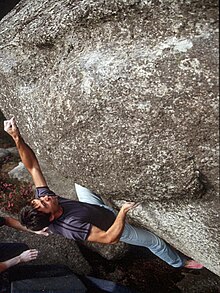 Undercling hold
Undercling hold - undercling
A hold which is gripped with the palm of the hand facing upwards.[9][47][48]
- undercut
- See undercling.
V[]
- "V"-grade
- A technical grading system for bouldering problems, invented by John Sherman.
- V-thread
A type of abseiling point used especially in winter and in ice climbing.
- verglas
- A thin coating of ice that forms over rocks when rainfall or melting snow freezes on rock. Hard to climb on as there is usually insufficient depth for crampons to have reliable penetration. See also clear ice and glaze ice.
- volume
- A large, hollow, bolted-on bouldering hold.
W[]
- wad
- A good climber. The term may have originated in Sheffield.[citation needed][47]
- wand
- A bamboo stick with a small flag on top used to mark paths over glaciers and snow fields.
- webbing
- A hollow and flat nylon strip, mainly used to make slings.Round webbing
- webolette
- A piece of webbing with eyes sewn into the ends which can be used in place of a cordelette.
- weighting
- Any time a rope sustains the weight of the climber, e.g. "weighting the rope". This can happen during a minor fall, a whipper (long fall), or simply by resting while hanging on the belay rope. See also hangdogging.
- whipper
- A lead fall from above and to the side of the last clip, whipping oneself downwards and in an arc. The term has come to denote any fall beyond the last placed or clipped piece of protection.
- wired
- A route or sequence that a climber has rehearsed extensively and thus ascends with ease. See dialled.
- wires
- See nuts.
- wolf moon
- To complete a lead climb during the nighttime.
- woodie
- A homemade climbing wall. Often specifically a hybrid between a climbing wall and a fingerboard. Specifically called such because of the wooden panels (usually left unpainted) used to attach the climbing holds.
X[]
- X (Protection Rating)
- A rating from the Yosemite Decimal System given to climbs that have very poor or no protection. These climbs often present risk of serious injury or death if a fall were to occur, even if the climb is properly protected.
 The left side of Black Velvet wall in Red Rock Canyon National Conservation Area features the five-pitch, sparsely protected Sandstone Samurai 5.11a X
The left side of Black Velvet wall in Red Rock Canyon National Conservation Area features the five-pitch, sparsely protected Sandstone Samurai 5.11a X - xeno
- A hold appearing to be composed of a different type of rock than the surrounding rock face.
Y[]
- yabo
- Another name for a sit start, named after .[49]
- yard up
To pull on the rope to make upward progress, often with assistance from the belayer. This may be done to bypass a crux or to quickly regain ground lost after a fall without re-climbing the section.
- Yosemite Decimal System
- A numerical system for rating the difficulty of walks, hikes, and climbs, used primarily in the United States. The rock climbing (5.x) portion of the scale is the most common grading system used in the US. The scale starts with the easiest grades at 5.0 and is open-ended on the harder end. As of September 2017, the most difficult grade was 5.15d.
Z[]
- zawn
- In the UK, a deep, narrow inlet in a sea cliff which is filled by the sea at high tide.
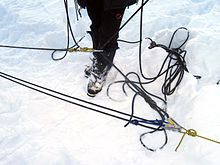 Z-pulley system
Z-pulley system - Z-clipping
- Clipping into a piece of protection with the segment of rope from beneath the previous piece of protection, resulting in a potentially dangerous tangled configuration of the belay rope. If not corrected, this can result in high drag.
- zipper fall
- A fall in which each piece of protection fails in turn. In some cases, when the rope comes taut during a fall, the protection can fail from the bottom up, especially if the first piece was not placed to account for outward and/or upward force.
- zone hold
- In competition bouldering, a hold roughly half way through a boulder which counts towards scoring. Formerly known as a bonus hold.
- Z-pulley
A particular configuration of rope, anchors, and pulleys typically used to extricate a climber after falling into a crevasse.
See also[]
- List of climbing topics – relating to climbing and mountaineering
- Climbing equipment – describes equipment used by climbers
- Glossary of caving and speleology
- Mountaineering: The Freedom of the Hills
References[]
- ^ Jump up to: a b c d "Rock Climbing Dictionary". Rock Climbing.com. Retrieved 2012-10-28.
- ^ Andrew Bisharat (6 October 2009). Sport Climbing: From Toprope to Redpoint, Techniques for Climbing Success. ISBN 9781594855139.
- ^ Bate, Chris; Arthur, Charles; et al. (8 May 2006). "A Glossary of Climbing terms: from Abseil to Zawn". UK Climbing. Retrieved 29 April 2018.
- ^ Ellison, Julie; Whitehead, JP (28 April 2016). "Training: 16 Climbing Games". Climbing. Retrieved 20 May 2019.
- ^ Raphaelson, Paul (2010). "ACR Anchor Method: The Alpine Cock Ring". Retrieved 20 May 2019 – via DocPlayer.net. Cite journal requires
|journal=(help) - ^ Weidner, Heather (11 November 2018). "Total Body Climbing: Use All Your Body Parts for Smart, Savvy Climbing". Climbing. Retrieved 20 May 2019.
- ^ Sanders, Charles J. "The Boys of Winter: Life and Death in the U.S. Ski Troops During the Second World War," University Press of Colorado 2011
- ^ Green, Stewart (23 February 2019). "Alpine Start in Mountaineering". ThoughtCo. Retrieved 20 May 2019.
- ^ Jump up to: a b c d e f g h i "Climbing Techniques and Moves | REI Expert Advice". REI. Retrieved 13 March 2019.
- ^ Jump up to: a b c d e f g h i j k "Intermediate Moves". ClimbingTechniques.org. Retrieved 13 March 2019.
- ^ "Demystifying the Ball Nut!". Sierra Mountain Guides. Retrieved March 23, 2018.
- ^ "Belay stations – Mountaineering Methodology". www.mountaineeringmethodology.com. Retrieved 8 December 2017.
- ^ "Bowline on a bight". Retrieved July 4, 2020.
- ^ Ward, Mick (18 October 2017). "Are You a Complete and Utter Bumbly? Take the Test!". UKClimbing.com. Retrieved 20 May 2019.
- ^ Van Leuven, Chris (15 June 2012). "The Heel-Toe Cam". Climbing. Retrieved 12 December 2016.
- ^ Jump up to: a b Buys, Jordan. "Use your knees!". UKClimbing.com. Retrieved 12 December 2016.
- ^ Milford, Ty (18 December 2015). "Climbing Tech Tips". Climbing. Retrieved 20 May 2019.
- ^ Kuehl, Matt (18 December 2015). "Don't Just Wing It: 6 Crucial Wide-Crack Techniques". Climbing. Retrieved 20 May 2019.
- ^ "Cold Shuts". www.peerlesschain.com. Retrieved 15 December 2017.
- ^ Long, John (2010). How to Rock Climb!. Rowman & Littlefield. p. 152. ISBN 9780762766741. Retrieved 15 December 2017.
- ^ "Glossary of Climbing Expressions". Tales from the rampage. 30 September 2014. Retrieved 13 March 2019.
- ^ "What is a dab in climbing?". What is a dab in climbing. 8 January 2021.
- ^ Mountaineering : the freedom of the hills. 2017. ISBN 9781680510034. OCLC 978286879.
- ^ "Climbing Movement: 17. The DeadPoint". Climbing Tech Tips. 20 August 2017. Retrieved 20 May 2019.
- ^ Jump up to: a b c d Cymerman, A; Rock, PB. "Medical Problems in High Mountain Environments. A Handbook for Medical Officers". USARIEM-TN94-2. US Army Research Inst. of Environmental Medicine Thermal and Mountain Medicine Division Technical Report. Archived from the original on 2009-04-23. Retrieved 2009-03-05. Cite journal requires
|journal=(help) - ^ Smith, Gary (31 August 2015). "A Route Description Glossary". Irish Mountaineering Club. Retrieved 20 May 2019.
- ^ Jump up to: a b Davis, Steph (25 April 2011). "Straight From the Mammoth's Mouth: Half Ropes Are Not Twins | Steph Davis – High Places". Steph Davis – High Places. Retrieved 9 December 2016.
- ^ Ellison, Julie (11 January 2013). "Extension Basics". Climbing. Retrieved 9 December 2016.
- ^ "Preventing Rope Drag". ClimbingTechniques.org. Retrieved 9 December 2016.
- ^ "Drilling Bolts? Do Not Do This!". Mountain Project. Retrieved 15 December 2017.
- ^ "Drilled Pitons in the desert". Mountain Project. Retrieved 15 December 2017.
- ^ Frommer, Harvey (2005). The Sports Junkie's Book of Trivia, Terms, and Lingo: What They Are, Where They Came From, and How They're Used. Taylor Trade Publishing. p. 308. ISBN 978-1-4616-2603-9.
- ^ Stewart Green. "French Free Climbing". About.com. Retrieved 2009-08-14.
- ^ Olver, Lynne. "Trail Mix". The Food Timeline. Retrieved 20 December 2017.
- ^ Jump up to: a b The Climbing Dictionary: Mountaineering Slang, Terms, Neologisms & Lingo
- ^ http://www.blackdiamondequipment.com/en_CA/ice-climbing-protection/express-ice-screw-BD4902100000ALL1.html
- ^ Climbing, Send. "Kneebar knowledge". Send Climbing. Retrieved 12 December 2016.
- ^ Sagar, Heather Reynolds (2001). Climbing Your Best: Training to Maximize Your Performance. Stackpole Books. ISBN 9780811727358.
use only the natural features in the wall texture ... attempt to substitute naturals on routes where they exist
- ^ "Naturals". Naturals | Aiguille's Rock Climbing Blog | Crimp Chronicles. 2009-11-02. Retrieved 2017-09-10.
- ^ "Definition: Poop Tube". www.davidlnelson.md. Retrieved 8 December 2016.
- ^ "How to Make a Poop Tube". wikiHow. Retrieved 8 December 2016.
- ^ "Stem Gem". Mountain Project. Retrieved 8 December 2016.
- ^ 20 climbing terms and their potentially nonsense origins
- ^ Petzl, "Sponsor Content: Simul-climbing with a Tibloc", Climbing, Retrieved Aug. 20, 2018
- ^ Banaszczyk J., "Hangboard Repeaters Strength Endurance Protocol." StrengthClimbing.com (2019): Apr. 8, 2019. https://strengthclimbing.com/hangboard-repeaters/
- ^ See, for example, Geoff Birtles's essay "Elder Crack", included in Hard Rock, edited by Ken Wilson (Hart-Davis MacGibbon, 1974).
- ^ Jump up to: a b Harris, Will (15 March 2016). "Climbing lingo: how to talk the talk". British Mountaineering Council. Retrieved 22 May 2019.
- ^ "We've all been there... starting out in climbing Part 2". The Boardroom Climbing. Retrieved 20 May 2019.
- ^ Carl Ockier. "The climbing dictionary". Retrieved 2007-02-20.
External links[]
- Bay Area Climbers (US)
- Mountainzone glossary A–L and M–Z
- Just Climb (US)
- UK Climbing (UK)
- A Climber's Glossary
- Rock Climbing UK Features a full section on climbing techniques and training plans.
Categories:
- Climbing
- Wikipedia glossaries
- Climbing techniques























